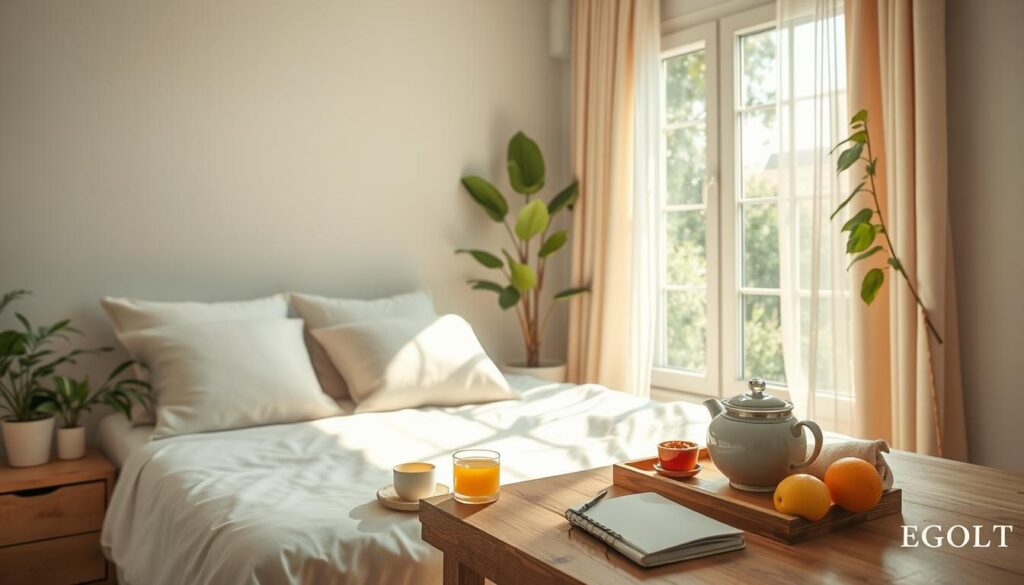In today’s fast world, self-care is key to a healthy life. This guide covers many self-care aspects. It offers practical tips for your physical, mental, and emotional health.

By creating a self-care plan that fits you, you can change your life. You’ll find more joy and balance in your life.
Key Takeaways
- Understand the fundamental components of self-care for a balanced life
- Discover the science behind the benefits of self-care practices
- Develop a morning wellness routine to set the tone for your day
- Explore mindfulness techniques to promote daily balance and stress relief
- Establish healthy boundaries in relationships to support your well-being
Understanding the Fundamentals of Self-Care Balanced Life
Self-care is about keeping a healthy and balanced life. It covers both physical and mental health. Each part is key to our emotional well-being. By learning about self-care, we can create a plan that fits our needs and likes.
Physical vs. Mental Self-Care
Physical self-care means taking care of our bodies. This includes eating right, exercising, and sleeping well. These actions help our physical health and energy, which boosts our mental and emotional health.
Mental self-care is about caring for our minds. It includes mindfulness, managing stress, and reflecting on ourselves. These activities help us stay emotionally strong.
The Science Behind Self-Care Benefits
Many studies show self-care is good for us. Practicing mindfulness can lower stress and improve focus. It also helps us manage our emotions better.
Putting emotional well-being first through self-awareness and coping can improve our mental health. It makes us feel more fulfilled.
Building Your Personal Self-Care Foundation
- Find out what you need and like: What makes you feel alive? What relaxes you? What makes you happy and gives you purpose?
- Try different self-care activities: Experiment with physical, mental, and emotional practices to see what works for you.
- Make self-care a daily habit: Plan time for self-care, like morning meditation, evening walks, or weekly creative projects.
- Change your self-care plan as needed: Update your self-care routine as your needs and life change.
By learning about self-care and making a plan that’s yours, you can live a balanced life. This life will nourish your body, mind, and spirit.

Creating Your Morning Wellness Routine
Starting your day with a wellness routine can change everything. It helps you face challenges with more focus and strength. By adding stress management techniques and restorative activities to your morning, you can feel more at peace and well.
Begin with a short meditation. Just 5-10 minutes can make you feel more grounded and ready for the day. Breathing exercises are also great for reducing stress and anxiety. Try adding a few minutes of deep breathing to your morning.
- Try a guided meditation app like Calm or Headspace to kickstart your practice.
- Experiment with box breathing or other breathing techniques to find what works best for you.
Moving your body is key in the morning. It could be yoga, a walk, or some stretching. Adding restorative activities boosts your energy and mood.
“The morning is the best time of day to set the tone for your entire day.”
Also, eat a healthy breakfast. Choose foods that are good for your mood and energy. Taking care of yourself in the morning prepares you for the day’s challenges.

Mindfulness Practices for Daily Balance
Achieving a balanced life is a big goal. Mindfulness practices are key to reaching it. By adding mindfulness to your daily routine, you can feel more mentally and emotionally well. This balance helps you connect with both your inner and outer worlds.
Meditation Techniques for Beginners
Meditation is great for quieting your mind and finding peace. If you’re new, start with focused breathing or body scans. These methods help you ignore distractions and stay present.
Breathing Exercises for Stress Relief
Stress can hurt our mental health and overall well-being. But, there are breathing exercises that can help. Try 4-7-8 breathing or box breathing to calm your mind and body.
Mindful Movement and Body Awareness
Mindful movement can improve your connection with your body. Activities like yoga, tai chi, or mindful walking increase body awareness. This leads to better balance and harmony.
Adding these mindfulness practices to your life can change you. It helps you deal with life’s ups and downs better. You’ll feel more mentally strong and resilient.
Establishing Healthy Boundaries in Relationships
Maintaining healthy boundaries is key for good relationships. It keeps your emotional well-being safe and helps you connect better with others.
Setting healthy boundaries means talking about what you need and want clearly. It’s about taking care of yourself while still caring for others. Here are some ways to set and keep healthy boundaries:
- Know your limits and what you can’t do. What makes you feel drained or unhappy?
- Talk about your boundaries in a kind way. Say “I prefer not to discuss work after 7 pm” or “I need time to myself on the weekends.”
- It’s okay to say “no” without feeling guilty. Politely turn down things that go beyond your limits. If you can, suggest something else.
- Respect others’ boundaries too. Don’t cross their lines and respect their need for privacy or alone time.
- Check and change your boundaries when needed. Your needs can change, and it’s good to be open to new things.
Having healthy boundaries leads to better relationships and less stress. It’s not about shutting people out. It’s about making a safe space for real connections.
“The best thing about setting boundaries is, it’s not just protection – it’s also freedom.” – Unknown
Nutrition as a Form of Self-Care
Eating the right foods is key to holistic wellness. What we eat greatly affects our mental health and overall well-being. Exploring how nutrition and self-care are linked can lead to a more balanced life.
Mood-Boosting Foods
“You are what you eat” is true for our emotional health. Foods rich in nutrients and antioxidants can greatly improve our mood and brain function. For example, dark chocolate, berries, and fatty fish boost serotonin and dopamine, helping with depression and anxiety.
Hydration and Energy Levels
- Drinking enough water is vital for energy and clear thinking.
- Water helps remove toxins, regulate body temperature, and carry nutrients.
- Not drinking enough water can cause fatigue, headaches, and poor focus, making self-care harder.
Mindful Eating Practices
Mindful eating changes how we view food and its impact on our health. By focusing on our senses and enjoying each bite, we appreciate our food more. This can make eating more fulfilling and reduce emotional eating.
| Mood-Boosting Foods | Hydration Benefits | Mindful Eating Practices |
|---|---|---|
| – Dark chocolate – Berries – Fatty fish |
– Flushes out toxins – Regulates body temperature – Transports essential nutrients |
– Tuning into senses – Savoring each bite – Being present during meals |
By eating mood-boosting foods, staying hydrated, and eating mindfully, we support our wellness and mental health. Taking care of our bodies through nutrition is a powerful act of self-care.
Digital Detox and Mental Clarity
In today’s world, it’s easy to get lost in digital noise. But, finding a balance between our digital and real lives is key for our mental health. The idea of a “digital detox” is becoming popular as a way to manage stress and find mental clarity.
Doing a digital detox means different things to different people. It could be as simple as setting limits on screen time or taking a break from all devices for a while. By stepping away from digital distractions, we can focus better, be more mindful, and relax more.
Practical Tips for a Successful Digital Detox
- Make some areas of your home tech-free, like the bedroom or dining room. This creates a digital sanctuary.
- Take regular breaks from your devices. Set times, like during meals or before bed, to unplug.
- Use apps or device features to limit your time on social media and other distracting sites.
- Choose activities that make you more present, like reading, journaling, or exercise.
- Spend more time with people you care about. Have real conversations and do things that don’t involve screens.
By using these stress management techniques and mental health strategies daily, you can improve your mental clarity. You’ll feel less anxious and overwhelmed. And, you’ll have a healthier relationship with technology.
| Benefits of Digital Detox | Potential Challenges |
|---|---|
|
|
Embracing digital detox can help you feel clearer mentally, reduce stress, and have a better relationship with technology. Start small and try different approaches to find what works for you.
“The ability to be in the present moment is a major component of mental wellness.”
Physical Activity and Movement for Well-being
Physical activity is key to a balanced life. It boosts our health and mood. It helps manage stress and improves our overall well-being.
Low-Impact Exercise Options
Looking for gentle exercises? Yoga, Pilates, and tai chi are great. They mix strength, flexibility, and mindfulness. Swimming, cycling, and brisk walking are also good for daily life.
Incorporating Movement Throughout the Day
Moving throughout the day is important. Simple stretches or a short walk can help. It keeps you active and energized, even when busy.
Exercise for Stress Relief
Exercise is a strong stress fighter. It releases endorphins, boosting mood and reducing anxiety. Adding exercise to your routine helps manage stress and balance life.
| Low-Impact Exercise Options | Benefits |
|---|---|
| Yoga | Improves flexibility, strength, and mindfulness |
| Pilates | Enhances core strength and body awareness |
| Tai Chi | Combines gentle movements with meditation for stress relief |
| Swimming | Provides a full-body workout with minimal impact on joints |
| Cycling | Improves cardiovascular fitness while being easy on the joints |
| Brisk Walking | Accessible and can be easily incorporated into daily routines |
Exploring different physical activities helps create a balanced self-care routine. It supports your self-care balanced life and helps manage stress.
Creating a Restorative Sleep Schedule
Quality sleep is key to holistic wellness and restorative activities. It greatly impacts our physical, mental, and emotional health. A consistent sleep schedule helps our body’s natural rhythms, leading to better sleep and rejuvenation.
To create a restorative sleep schedule, consider these strategies:
- Stick to the same bedtime and wake-up time every day, including weekends. This helps your body’s internal clock, making sleep and waking easier.
- Have a calming pre-bed routine, like a warm bath, gentle stretches, or light reading. These signals to your body it’s time to sleep.
- Make your sleep space perfect for rest. Keep it cool, dark, and quiet. Use blackout curtains or an eye mask if needed.
- Stay away from screens like phones, tablets, and laptops an hour before bed. Their blue light can mess with your sleep cycle.
- Try relaxation techniques like deep breathing or meditation to calm your mind before bed.
By focusing on a restorative sleep schedule, you can enjoy many benefits. These include better thinking, mood, and physical recovery.
| Benefits of a Restorative Sleep Schedule | Factors for a Restful Sleep |
|---|---|
|
|
Embracing a restorative sleep schedule is vital for holistic wellness. It unlocks the benefits of quality rest, helping you live a balanced and rejuvenated life.
Emotional Intelligence and Self-Awareness
Embracing emotional well-being and developing strong mental health strategies are key to a balanced life. We’ll explore emotional intelligence and self-awareness. These tools help you manage your emotions and build resilience.
Understanding Your Emotional Triggers
Identifying your emotional triggers is the first step to emotional well-being. What situations or interactions make you feel strongly? Knowing these triggers helps you manage your reactions and support your mental health.
Developing Coping Mechanisms
After finding your emotional triggers, it’s time to build coping strategies. This might include mindfulness, journaling, or hobbies. Trying different methods helps you find what works best for you in managing stress and keeping your emotions balanced.
Building Emotional Resilience
- Develop self-awareness: Understand your emotions, strengths, and weaknesses to foster personal growth.
- Practice self-compassion: Be kind to yourself and avoid harsh self-criticism, which can undermine emotional well-being.
- Cultivate a growth mindset: Embrace challenges as opportunities for learning and personal development.
- Seek support: Surround yourself with a network of trusted individuals who can provide emotional support and guidance.
Nurturing your emotional intelligence and self-awareness helps you handle life’s challenges better. It leads to a deeper sense of well-being and resilience.
“Emotional intelligence is the ability to identify and manage your own emotions and the emotions of others.”
Work-Life Balance Strategies
Finding a balance between work and life is key to happiness and well-being. Today’s fast pace can make it hard to balance work and personal life. But, with the right strategies, we can achieve a balance that supports both our careers and personal lives.
Effective time management is a big help. By focusing on what’s most important, setting realistic goals, and delegating tasks, we can have more time for hobbies, friends, and ourselves. Work-life harmony is about finding the right mix, not trying to do everything at once.
It’s also important to set clear boundaries between work and personal life. This might mean having set work hours, turning off work notifications, or having a dedicated workspace at home. Keeping these boundaries helps us feel in control and boosts our sense of life satisfaction and renewal.
- Prioritize your time and tasks to focus on what’s most important.
- Set clear boundaries between work and personal life, and stick to them.
- Delegate or outsource responsibilities to free up time for self-care and leisure.
- Engage in stress-relieving activities, such as exercise, meditation, or hobbies, to recharge.
- Communicate openly with your employer or colleagues about your need for work-life balance.
| Strategies for Work-Life Balance | Benefits |
|---|---|
| Time Management | Increased productivity, reduced stress, more time for personal life |
| Boundary Setting | Improved mental well-being, enhanced job satisfaction, better work-life integration |
| Stress Management | Better physical and emotional health, improved focus and creativity |
| Open Communication | Stronger relationships with colleagues, increased understanding and support |
By using these work-life harmony strategies, you can live a more balanced and fulfilling life. This leads to greater life satisfaction in both your personal and professional life.
“The key is not to prioritize what’s on your schedule, but to schedule your priorities.” – Stephen Covey
Social Connections and Support Systems
Keeping strong social ties and support systems is key to self-care and happiness. Building real connections not only boosts our happiness but also gives us a sense of belonging. It also helps us feel supported when things get tough.
Building Meaningful Relationships
Creating healthy relationships takes time, effort, and a real desire to connect with others. Here are some ways to build strong connections:
- Spend quality time with loved ones, like having regular meet-ups or outings.
- Listen well and show real interest in what others say.
- Be open and share your feelings and experiences to deepen connections.
- Support your loved ones when they need it most.
Community Involvement Benefits
Getting involved in your local community can also boost your well-being. By volunteering, joining clubs, or attending community events, you can:
- Meet new people who share your interests.
- Help a cause you believe in, giving you a sense of purpose.
- Learn new things and grow personally.
- Feel more connected to your community and the people in it.
Setting Social Boundaries
It’s important to build strong social ties, but setting healthy boundaries is just as crucial. Clear boundaries help keep your life balanced and prevent burnout. Here are some tips for setting boundaries:
| Boundary | Benefits |
|---|---|
| Limit screen time and digital communication | Reduces constant connection and encourages more face-to-face time |
| Decline invitations or requests that don’t fit your priorities | Helps keep your work and personal life in balance and protects your time |
| Communicate your needs and preferences clearly | Makes sure your boundaries are respected and avoids misunderstandings |
By nurturing meaningful relationships, getting involved in your community, and setting healthy boundaries, you can build a strong support system. This system will improve your life satisfaction and overall well-being.
Creative Expression for Mental Health
Doing creative things can really help your mental health. It’s a way to express yourself and find balance. It can make you feel more at peace.
Being creative can make you feel less stressed and anxious. When you’re lost in a creative project, like painting or writing, you forget about daily worries. This focus can calm you down and make you feel relaxed.
Also, creative activities can make you happier and more confident. Making something real can make you feel proud and happy. It releases good feelings in your brain, like dopamine and serotonin.
- Painting, drawing, or coloring can be a meditative and calming experience, allowing you to express your emotions through visual art.
- Writing, whether it’s journaling, poetry, or creative fiction, can be a powerful way to process your thoughts and feelings.
- Engaging in DIY projects, such as crafting, woodworking, or pottery, can provide a sense of accomplishment and pride.
- Listening to music, playing an instrument, or even dancing can be a form of creative self-expression that can lift your mood and reduce stress.
Adding creative activities to your self-care can change your life. It lets you connect with yourself and see things in new ways. It’s a powerful way to find peace through art.
“Creativity is not just for artists. It’s for everyone. We all have the capacity to be creative. We all have something to contribute.” – Sir Ken Robinson
| Creative Activity | Mental Health Benefit | Recommended Duration |
|---|---|---|
| Painting or Drawing | Stress relief, improved mood, increased focus | 30-60 minutes per session |
| Journaling | Emotional processing, self-reflection, enhanced self-awareness | 15-30 minutes per day |
| DIY Crafting | Sense of accomplishment, increased mindfulness, stress reduction | 60-90 minutes per session |
| Music Listening or Playing | Mood enhancement, reduced anxiety, improved cognitive function | 30-60 minutes per day |
Adding creative expression to your mental health plan can be very healing. Try different things to see what works best for you. It’s a great way to enjoy the benefits of art.
Financial Well-being as Self-Care
Financial well-being is key to self-care. It affects our lifestyle balance and satisfaction. By focusing on financial health, we can invest in things that improve our well-being.
Budgeting for Self-Care Activities
Creating a budget for self-care is important. It lets you plan for activities that refresh and recharge you. This could be for therapy, fitness, healthy food, or a relaxing trip. Showing self-care in your budget shows you care about your well-being.
Investment in Personal Growth
Seeing personal growth as self-care motivates you to spend on learning and skills. These investments boost your knowledge and confidence. They help you feel empowered and fulfilled, essential for a balanced life.
Money Mindfulness
Being mindful with money is part of self-care. It helps you understand your spending and beliefs about wealth. This awareness leads to better financial decisions, less stress, and more control over your life.



